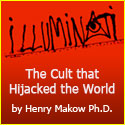James Perloff - Exploding the Official Myths of the Lincoln Assassination
July 8, 2024

"Readers may be surprised at how much 1860s America
resembled today's America, with a Deep State
behind the scenes, controlled information,
suppression of civil liberties, and secret agendas."
by James Perloff
(henrymakow.com)
Like many major historical events, the Abraham Lincoln assassination had an official story and back story. The official story is pretty well known.
On April 14, 1865, five days after Confederate General Robert E. Lee had surrendered to Ulysses S. Grant, effectively ending the Civil War, the President and his wife attended a comedy at Ford's Theatre in Washington. At about 10:15 PM, famed actor John Wilkes Booth--a Southern sympathizer--entered the Presidential box and assassinated Lincoln with a shot to the back of the head. Booth leapt to the stage below, but caught his spur on the American flag draping the ledge, causing him to fall so awkwardly that he broke his leg. But this didn't prevent him from yelling "The South is avenged!" to the stunned audience and escaping out the back of the theater.
Simultaneously, a Booth accomplice, Lewis Powell, attempted to stab to death William Seward, the Secretary of State, at his home. Though not expected to live, Seward survived his wounds.
Booth and another accomplice, David Herold, rode south. Though his broken leg was splinted in Maryland by Dr. Samuel Mudd, the injury significantly slowed Booth. On April 26, Union cavalry tracked the pair to a Virginia barn. Herold surrendered; Booth refused. Despite orders to bring him back alive, Booth was mortally wounded by a soldier who fired through an opening in the barn.
Afterwards, a military court tried eight alleged Booth accomplices. Four were hanged--including Mary Surratt, the first woman executed by the United States--and four sentenced to prison at hard labor.
So ends the official story in a nutshell, which is all most people know, due to media control plus removal of critical documents from government archives. Readers may be surprised at how much 1860s America resembled today's America, with a Deep State behind the scenes, controlled information, suppression of civil liberties, and secret agendas.
So ends the official story in a nutshell, which is all most people know, due to media control plus removal of critical documents from government archives. I dismantle that story in my just-released book Exploding the Official Myths of The Lincoln Assassination, thanks to digitization of handwritten 19th century documents, and with help from two intrepid predecessors--one alive, the other dead for more than 60 years. Readers may be surprised at how much 1860s America resembled today's America, with a Deep State behind the scenes, controlled information, suppression of civil liberties, and secret agendas.

Among the questions the book asks--sometimes answering, sometimes just asking:
● Why, on a dishonest pretext, did Secretary of War Edwin Stanton deny Abraham Lincoln the protection he requested at Ford's Theatre?
● Why was Lincoln assigned a disreputable bodyguard who deserted his post shortly before the assassination?
● Why was the bodyguard not reprimanded, and his name virtually erased from history?
● How did John Wilkes Booth know he only needed a one-shot derringer to dispose of the President?
● Although many mainstream historians claim Booth and his accomplices intended to kill Lincoln's whole cabinet, why were the only ACTUAL assassination attempts made against the only two prominent men in the administration--Lincoln and Seward--who stood in the way of the brutal plan of Reconstruction for the South, devised by Stanton and the "Radical Republicans"?
● In what ways was the Presidential box at Ford's Theatre modified to facilitate the murder?
● Why did Washington's telegraph wires shut down right after the assassination?
● Why did War Secretary Stanton take charge of the investigation, which more properly fell under the Attorney General's jurisdiction?
● How did Booth and Herold escape Washington so easily via the guarded Navy Yard Bridge, even though there was an order to let no unauthorized person cross after 9PM, a curfew that had been in effect for more than two years, and that Booth surely knew about?
● Why wasn't the sergeant who let the two pass, in violation of standing orders, reprimanded?
● Why was the road that Booth and Herold took the only road Stanton left unpatrolled after the assassination?
● What did Booth tell Southerners was his real reason for leaving a card at the residence of Lincoln's new Vice President, Andrew Johnson, on the day of the assassination?
● Secretary Seward's would-be assassin, Lewis Powell, gained access to the home by pretending to be a pharmacy delivery boy--he knew the name of Seward's physician, and the house's exact layout. Where did he get his inside information?
● Why were the soldiers close to capturing Booth ordered to halt, while, at the cost of an extra day's time, a select detachment was sent from Washington, including two commanders who were trusted associates of Stanton's right-hand man Lafayette Baker?
● Why was the court-martial of Sergeant Boston Corbett--who, against orders, allegedly shot Booth--cancelled?
● Why was Booth's diary, recovered from his body, never introduced in evidence at the conspiracy trial, kept secret for two years--and when finally exposed, were 43 sheets (86 pages) missing?
● Why were Booth's alleged accomplices denied a jury trial, and disallowed defense counsel until approximately the proceedings began?
● Why were they continuously shackled with hoods over their heads before being either hanged or sentenced to the remote island prison in Dry Tortugas--west of Key West?
● Why was Mary Surratt hanged the very day after her sentence was pronounced?
● Who was the "snitch" who lived in Mrs. Surratt's boardinghouse while simultaneously working in the War Department, and why did a court stenographer call him a perjurer?
● What demand did Stanton make of Mrs. Surratt's priest, as the condition for being allowed to give her final sacraments?
● What close friend of Booth, an actor who performed at Ford's Theatre on the night of the assassination, was also old friends with William P. Wood, Stanton's intelligence chief?
● Booth was well-known to carry a swagger stick, with which he posed in 11 different photographs. What inscription--perhaps relevant to the assassination--was engraved on its gold-plated handle?
● When Edwin Stanton was on his deathbed, visions of what person did he say haunted him day and night, such that "he could not live under the pressure he was bearing"?
https://www.amazon.com/dp/0966816064?ref_=pe_93986420_774957520 . 153 pages, 166 endnotes, over 30 illustrations, indexed. A Kindle edition is forthcoming. James Perloff's website is https://jamesperloff.net/.







R said (July 10, 2024):
I have read that Booth was a Mason tasked to kill Lincoln who defied bank of England and their extortion financing for the war. Lincoln printed American money know as greenbacks. That apparently is a mortal sin. JFK committed the same thought crime.